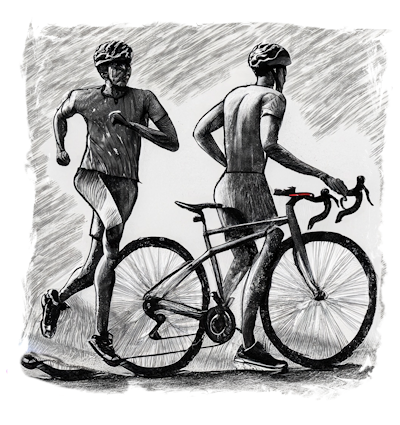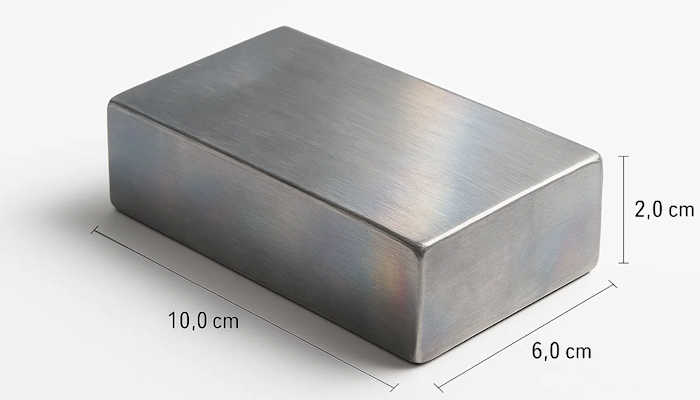
 |
Exam-Style Questions.Problems adapted from questions set for previous Mathematics exams. |
1. | GCSE Higher |
Bruce cycles a distance of 30 km at an average speed of 20 km/h.
He then runs a distance of 8 km at an average speed of 6 km/h.
Work out the total time Bruce takes.
Give your answer in hours and minutes

2. | GCSE Higher |
A builder needs to lift a steel block. It is a cuboid with dimensions 2 m by 0.2 m by 0.2 m. Steel has a density of 7.6 g/cm3.
The builder's lifting gear can lift a maximum load of 500 kg. Can the lifting gear be used to lift the steel block?
Justify your decision.
3. | GCSE Higher |
A cuboid made of solid metal measures 10.0 cm by 6.0 cm by 2.0 cm. The block’s mass is 600 g.
Work out:
(a) the volume of the cuboid
(b) the density of the metal in g/cm³
(c) the density of the metal in kg/m³

4. | GCSE Higher |
The density of lemon juice is 1.15 grams per cubic centimetre.
The density of lime juice is 1.25 grams per cubic centimetre.
The density of soda water is 0.97 grams per cubic centimetre.
400cm3 of a lemon and lime drink are made by mixing 30cm3 of lemon juice with 30cm3 of lime juice and then soda water is added to make up the rest of the drink.
Find the density of the lemon and lime drink correct to two decimal places.
5. | GCSE Higher |
Strat drove from Wolverhampton to London via Coventry.
(a) Work out Strat's average speed for his total drive from Wolverhampton to London.
Raven drove from Bedrock to Springfield via South Park.
Raven says that the average speed from Bedrock to Springfield can be found by working out the mean of 70 km/h and 50 km/h.
(b) If Raven is correct, what does this tell you about the two parts of Raven's journey?
6. | GCSE Higher |
A batch of coins is made from an alloy consisting of 270g of copper mixed with 90g of nickel.
(a) Work out the volume of copper used in the alloy.
(b) What is the density of the alloy to three significant figures?
7. | GCSE Higher |
The density of water (at 20°C) is 1.09 g/cm3.
The density of blood is 1.60 g/cm3.
Three litres of water are mixed with four litres of blood for a scientific experiment. Work out the density of the mixture giving your answer correct to 2 decimal places.
8. | GCSE Higher |
9 cup cakes weigh a total of 204 g.
There are 420 calories in 100 g of cup cakes.
How many calories are there in one cup cake?









9. | GCSE Higher |
The distance from Wolverhampton to Cambridge is 115 miles.
Lynn drives from Wolverhampton to Cambridge leaving Wolverhampton at 10:30am. She assumes that her average speed will be 55 mph.
(a) Use Lynn's assumption about her average speed to work out her arrival time in Cambridge.
(b) Lynn's speed was actually lower than her assumption. How does this affect the arrival time?
10. | GCSE Higher |
The following kinematics formula can be used to work out the distance travelled (displacement) of an object travelling with constant acceleration.
$$ s = ut + \frac12 at^2 $$where:
(a) Rearrange the formula to make \(u\) the subject.
(b) What units would be associated with speed in this case?
(c) What units would be associated with acceleration?
11. | GCSE Higher |
Harper mixes 300g of material \(X\) and 150g of material \(Y\) to make 450g of a compound material.
Material \(X\) has a density of 20g/cm3.
Material \(Y\) has a density of 15g/cm3.
Work out the density of the compound material.
If you would like space on the right of the question to write out the solution try this Thinning Feature. It will collapse the text into the left half of your screen but large diagrams will remain unchanged.
The exam-style questions appearing on this site are based on those set in previous examinations (or sample assessment papers for future examinations) by the major examination boards. The wording, diagrams and figures used in these questions have been changed from the originals so that students can have fresh, relevant problem solving practice even if they have previously worked through the related exam paper.
The solutions to the questions on this website are only available to those who have a Transum Subscription.
Exam-Style Questions Main Page
To search the entire Transum website use the search box in the grey area below.
Do you have any comments about these exam-style questions? It is always useful to receive feedback and helps make this free resource even more useful for those learning Mathematics anywhere in the world. Click here to enter your comments.